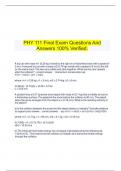Exam (elaborations)
PHY 111 Final Exam Questions And Answers 100% Verified.
PHY 111 Final Exam Questions And Answers 100% Verified.
A .toy .car .with .mass .m1 .(0.36 .kg .) .travels .to .the .right .on .a .frictionless .track .with .a .speed .of .3 .m/s. .A .second .toy .car .with .a .mass .m2 .(0.74 .kg) .travels .with .a .speed .of .6 .m/s .to .the .left .on .t...
[Show more]
Preview 3 out of 16 pages
Uploaded on
August 23, 2024
Number of pages
16
Written in
2024/2025
Type
Exam (elaborations)
Contains
Questions & answers
phy 111 final exam questions and answers 100 ver
a toy car with mass m1 036 kg travels to the r
a student fires a 007 kg arrow at an object with
Institution
PHY 111
Module
PHY 111
£10.26
100% satisfaction guarantee
Immediately available after payment
Both online and in PDF
No strings attached
PHY 111 Final Exam Questions And




